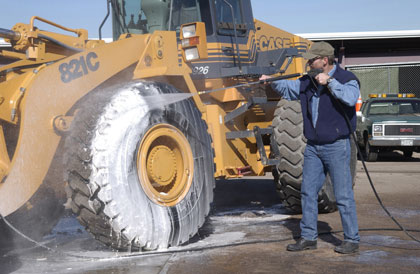Why is dirt removal so important to construction, mining and oil/gas professionals? Dirt, grime and grease are some of the toughest opponents to a successful heavy-duty equipment maintenance program. Some of the most serious problems dirt can cause on heavy equipment include:
Add over a thousand pounds of weight to an earthmover
- Clog an air cooled shovel to point of collapse
- Foul a diesel tractor engine into failure
- Bring tracked vehicles to a grinding halt
- Slow down hydraulic cylinders
- Corrode wiring
- Destroy components
- Make engines run at excessive temperatures, increasing both fuel consumption and the possibility of cracked blocks
Economics tell us that dirt, grime, and grease can cripple equipment performance and dramatically increase operating costs. Economics also dictate that a regularly scheduled machinery cleaning program should be established to spot potential problem areas before they become serious. Machinery must be clean before painting and should be clean before repairs or routine servicing.
Some mechanics report that they spend up to 20 percent of their time cleaning parts at their workbench or cleaning machinery so that parts can be either removed or replaced. That’s one hour out of every five spent cleaning. These are just some of the reasons a routine machinery cleaning practice should be included in the PM program.
 BASIC CLEANING PROGRAM
BASIC CLEANING PROGRAM
The cleaning program outlined below provides basic guidelines that can, over the long term, save on repair costs, reduce labor time, and save on fuel costs. Daily, on-site, preventive cleaning. Utilizing a high volume, medium pressure, portable cold-water washer for a few minutes of cleaning will greatly extend machinery life. It will rinse clogged radiators and oil coolers, free crawler tracks, and clear air intakes. All of this can be performed on the jobsite. A portable wash pad can be easily placed under the equipment to catch any water run-off, which can then be picked up with industrial shop vacs. On-site cleaning can catch leaks and cracks before problems escalate to major repairs.
ON-SITE INSPECTION OF VEHICLES AND MACHINERY
Daily cleaning of vehicles, as part of preventive maintenance outlined in the above step, will catch major problems. However, it is also recommended that a thorough inspection be done in the field after each 600-hour operational cycle. A few minutes cleaning with a trailer-mounted hot water pressure washer insures that grease, oil, and dirt are removed for proper inspection. In-field inspectors can spot a metal fissure, cracked block, or hydraulic leak. Trailer-mounted, hot water pressure washers operate in excess of 3000 psi and at temperatures up to 200 degrees F to insure complete removal of contaminants found on heavily used machinery. Most units carry their own fresh water supply, use either gas or diesel engines, and operate independently for complete portability. They, too, can be matched with a portable wash pad for a complete in-field cleaning system.
IN-SHOP MAINTENANCE FOR COMPLETE TEARDOWNS
Any successful machinery maintenance program includes in-shop, scheduled repairs and rebuilding of components. Sometimes this includes cleaning prior to painting. If so, a thorough cleaning system is needed for heavy duty work and should include an efficient wash pad design, stationary pressure washer(s), remote stations for convenient operator use, cabinet parts washers for automatic cleaning of components, and specialized floor care products (sweepers, scrubbers, and vacs) to keep the shop clean, safe, and professional.
Pressure washers are literally “money machines” because they generate the following savings for users:
Save time. Pressure washers clean 4 to 5 times faster than traditional methods. Cleaning effectiveness can be measured in Cleaning Units. A Cleaning Unit is calculated by taking the volume (gpm or gallons per minute) times the pressure (psi or pounds per square inch.) For example, a 3 gpm 2000 psi pressure washer generates 6,000 Cleaning Units while a 4 gpm 3000 psi unit generates 12,000 Cleaning Units—a 100 percent increase in cleaning effectiveness.
Save labor. Shorter cleaning time means reduced labor. Reduced labor means more productivity or less employee overtime. It all translates to more “bang” for the buck.
Save water. Surprisingly, a pressure washer uses much less water than other cleaning methods. For instance, the typical garden hose puts out between 6 to 10 gallons per minute. The typical pressure washer uses between 2 to 5 gallons per minute—a 50 to 70 percent savings in water usage.
Save equipment. A fact of life is that clean equipment runs cooler, is easier to service, and lasts longer. A pressure washer helps customers protect their investment in machinery, trucks, and other equipment. ■
About the Author: Keith Price is vice president, Shark Sales Division, of Karcher North America, Construction Division Products. For more information on heavy-duty cleaning products for construction, call 800.804.8536, or visit www.sharkpw.com.
[divider]
Modern Contractor Solutions, April 2014
Did you enjoy this article?
Subscribe to the FREE Digital Edition of Modern Contractor Solutions magazine.




 BASIC CLEANING PROGRAM
BASIC CLEANING PROGRAM